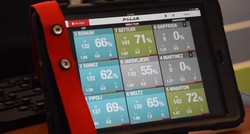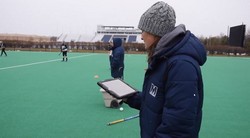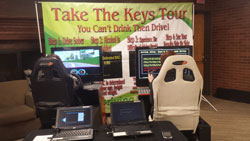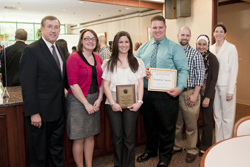The University will be entering its second year of a five-year grant allowing athletic teams to use the Polar Team Pro performance tracking system.
According to their official website, Polar Team Pro combines GPS and motion tracking technology with heart rate monitoring to create the ultimate solution for player performance tracking in team sports. The Polar Team Pro system allows you to wear a strap and a heart rate monitor around your chest. After a hard workout, you plug the monitor and clip it back on the board, so that the data can be synced to the iPad provided.
“A person’s heart rate can tell us how much stress the athlete is experiencing at a given time throughout the year: off-season, pre-season, and in-season. The heart rate isn’t the only thing that the Polar Team Pro system can do; however, it measures accelerations, decelerations, running distance (volume), and speed (intensity),” said Strength and Conditioning Assistant Bri Rubino. The additional factors give the strength and conditioning professionals the complete story in terms of the physiological stress that an athlete endures in lift, practice, and games.
“Many of us have developed training plans over time based on trial and error as well as scientifically-backed research that has worked for others in the field, but the Polar Team Pro system makes this much easier,” said Rubino. She explained that she feels that it is no longer necessary to guess which energy system is being taxed during a given conditioning session or drill.
“The heart rate monitors tell us what heart zone each athlete is currently in and what percentage of time they are in each zone. There is no longer a need to guess how long it will take an athlete to recover from a difficult practice or game,” she said.
 “The grant was used to buy them (Polar Team Pro) in the beginning, and we have just a little bit of money for replacements. By the end of five years they are all going to have to be replaced and I assume the replacement costs will increase every year,” said Marilyn McNeil, Ph.D., Vice President and Director of Athletics. The cost of the devices, including individual heart rate monitors, straps, and iPads, was $90,000. “I knew it was something that we couldn’t put in our operating budget so the only chance we had was with a grant.”
“The grant was used to buy them (Polar Team Pro) in the beginning, and we have just a little bit of money for replacements. By the end of five years they are all going to have to be replaced and I assume the replacement costs will increase every year,” said Marilyn McNeil, Ph.D., Vice President and Director of Athletics. The cost of the devices, including individual heart rate monitors, straps, and iPads, was $90,000. “I knew it was something that we couldn’t put in our operating budget so the only chance we had was with a grant.”
“The attraction for me was number one, the athlete can see what’s going on,” said McNeil. The ability to show that an athlete worked for a certain amount of time, at this pace, for this long, “that to me is great feedback,” said McNeil. McNeil, a former coach, believes the ability to see that kind of data that the Polar Team Pro system has, would have offered some great insight. “I would have loved to have that kind of feedback. That’s what kind of got me going,” she said.
“The games, especially in the beginning with the heat and everything that the [ Polar Team Pro system] really, really helped, where Bri Rubino would be on the side for home games and say, ‘Josephine’s in the red and she’s been there,’ and you can physically see them breaking down on the field,” said Head Field Hockey Coach Carli Figlio. The ‘red zone’ represents the current heart rate that a player has. Speed zones allow you to define the intensity of a training session with speed or pace.
These zones are customizable for different sports. The colors range from green, to red, with red being a high work volume. The University, she feels, have rotated players more this year than we ever have in the past. With the rotation, [Monmouth’s] Field Hockey has proved to be more consistent. “What I’ve found this year is our practices have been shorter, our drills are shorter, but the girls are in as good a shape as they were with longer practices and longer runs so, we’ve had less injury and less mental fatigue too,” said Figlio.
Rubino feels this tool can also help shift the performance of athletes. “Our teams on campus that have used the Polar Team Pro system have seen results, an increase in fitness level, and a reduction in ‘burnout’ that can pop-up towards the end of a season if athletes are over-trained,” said Rubino. What has become possible with the Polar Team Pro system is the realistic ability to text a coach after going through the data and suggest that an athlete takes off certain drills at the next day’s practice or during the week. Rubino feels that this allows them to recover enough to continue performing at a high level.
Having someone who is capable of analyzing all the data is very helpful for the University and can give them suggestions, as well as explain readings. “Bri [Rubino]’s expertise is going to help us be able to analyze the data and sort of express it to the kids, essentially, be able to translate it to you guys (women’s lacrosse players),” said Head Women’s Lacrosse Coach Jordan Trautman. With the information from the Polar Team Pro system, Monmouth can tailor the conditioning and drills to the needs of the individuals based on their sensor readings.
In terms of looking at the iPad that holds data that athletes can view in real time, “It’s funny to see who’s competitive in that way and it was surprising. Especially right now, they (field hockey players) have forgotten about the iPad because they are so involved in practice,” said Figlio.
Figlio explained that he feels this was not the case at the beginning, though, as the field hockey players were very interested about seeing who was in the red and who was not. “There is always talk to the younger kids, ‘What is your motivation?’ I think that the Garmin watch (heart rate tracking device) and this (Polar Team Pro system) have helped us almost take individual athleticism to the next level. When you compete with yourself and can see the actual results, I think that’s the biggest thing. There is an ability to see the results from when we started in August, until now,” said Figlio.
“I feel that this can help them (the coaches) recognize who might need to do more work so that the team’s condition can elevate as a whole,” said Mackenzie Rendich, a senior health studies student and Women’s Lacrosse player.
“However, these results don’t really dictate and evaluate individual ‘skills’ wise,” said Rendich. “For example, it may seem like someone is not in the best shape they could be for their sport, but that person might also be very strong lacrosse wise.
“This is a tool to be one percent better, day by day, so it gives us an opportunity to elevate that training in a unique and very specific way,” said Trautman. “Having Rubino, she feels, is a crucial aspect to knowing what the data these sensors are picking up means. It is nice having her to dissect the readings and workload as well as sprints and all that kind of stuff. “She knows that my question is going to be ‘do they work hard’ and she can translate that.”
While there has been praise for these devices, some felt they were not the most comfortable to wear at first. “When we first got them, they felt weird to wear. I felt that it was harder to breathe having something around my chest, but now that I have gotten used to it, I barely notice that it is there,” said Rendich.
Women’s soccer team member Alli Deluca, whose team also uses the Polar Team Pro system, has not even noticed that she is wearing it and appreciates the feedback she has gotten.
“The heart rate monitors have not affected my play whatsoever,” said Deluca. “I am never aware I am wearing it. I have recognized positive information about myself through the heart rate monitors.”
He continued and said, “I have been told that I am a hard worker on the field and give my full effort all game long. These heart rate monitors confirmed this for me. An example is when I was running all game long against Siena and found out after a game that I ran 11 miles,” said Deluca.
PHOTOS COURTESY of Monmouth Athletics




